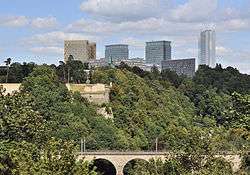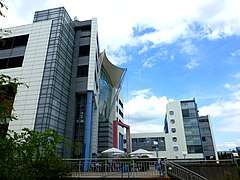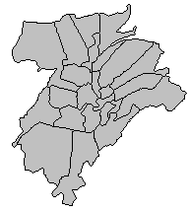Kirchberg, Luxembourg
Kirchberg (Luxembourgish: Kierchbierg) is a quarter in north-eastern Luxembourg City, in southern Luxembourg. It consists of a plateau overlooking the north-east of the historical city centre, Ville Haute, connected to the rest of the elevated city by the Grand Duchess Charlotte Bridge, which spans the Pfaffenthal valley. It is often referred to as the Kirchberg plateau, or simply, the Kirchberg by Luxembourg residents. Kirchberg is the predominant location of the European Union institutions and bodies based within Luxembourg, and is sometimes used as a metonym for the EU's judiciary, which occupies the quarter. It is thus the central business district of Luxembourg.
Kirchberg Kierchbierg (Luxembourgish) | |
|---|---|
 | |
 Kirchberg is one of 24 quarters in Luxembourg City | |
| Coordinates: 49.627869°N 6.153422°E | |
| Country | Luxembourg |
| Commune | Luxembourg City |
| Area | |
| • Total | 3.3684 km2 (1.3005 sq mi) |
| Population (31 December 2019)[2] | |
| • Total | 6,238 |
| • Density | 1,900/km2 (4,800/sq mi) |
| Nationality | |
| • Luxembourgish | 25.23% |
| • Other | 74.77% |
| Website | Kirchberg Plateau |
History
Although Kirchberg is first mentioned in historical records in 1222, one may assume there was an earlier settlement there, due to its useful location close to the Roman road from Reims to Trier. Little now remains of this Kiemwee (Roman road), but around 1900 it was still a popular walking destination for the city's inhabitants. In that year, the historian Nicolas van Werveke declared in a speech: "Who among us does not know the Kiem of Grünewald, [...] it is so well preserved on the whole stretch of the plateau, to the point where it leaves the forest, that one may boldly consider this part of the road one of the best-preserved of Gaul." The term "Kirchberg" which translates to "church hill" from German, was already used before the area had its own church. Kirchberg, as well as Neudorf, belonged to the parish of Weimerskirch. As Neudorf did not have its own church for a long time, on Sundays its inhabitants had to climb the hill between them and Weimerskirch to get to the church there. So the "Berg zur Kirche" ("hill to the church") became the "Kirchberg", the church hill.[3]
The isolated elevated position of the plateau made it an important defensive position and led to the 1732 construction of Forts Thüngen and Olizy in southeastern Kirchberg, as part of Luxembourg's impressive fortifications. Its strategic importance was reaffirmed with several expansions to their battlements. However, much of Luxembourg's fortifications were destroyed following the 1867 Treaty of London. In 1875, the Parish Church of Our Lady, Refuge of the Sick[nb 1], was built to serve a small farming community that had established themselves in central Kirchberg.
Kirchberg remained largely undeveloped until the post-war period in the latter half of the 20th century, when its cheap land, and proximity to the city provided an attractive locality as the seat of various institutions of the European Communities - the forerunner to today's European Union (EU).[5] The failure of the six founding states of the European Coal and Steel Community (ECSC) to agree on a single basis for its institutions' location, had led to Luxembourg becoming its provisional seat upon the ECSC's creation in 1952. However, with the development of the European Economic Community and the European Atomic Energy Community, other cities had successfully bid for their institutions - noticeably Brussels and Strasbourg. Discussions leading up to the 1965 Merger Treaty, which merged the governing institutions of the three communities, focused on resolving the deadlock in finding a single basis for the three communities' institutions. The Luxembourg government, seeking to retain and further attract the communities' institutions, commissioned the construction of the Grand Duchess Charlotte Bridge, spanning the Pffafenthal valley, to connect the Kirchberg plateau directly with Limpertsberg, and the rest of the elevated city, opening up its cheap land for development for the communities. The Luxembourg government's efforts were successful and today Luxembourg is considered one of the EU's three de facto capitals,[5] retaining several institutions, most importantly, the Court of Justice.
Contemporary developments
The development of the European district acted as a catalyst for the urbanisation of Kirchberg, promoted by the government initiative, the Fonds Kirchberg. The architecture of the Kirchberg plateau is notably modern.
The major components of Kirchberg's urbanisation were drawn up by French architect Pierre Vago, with its central axis being the 3.5 km long Avenue John Fitzgerald Kennedy stretching from the Grand Duchess Charlotte Bridge in southwest Kirchberg to the edge of the Grünewald forest on the north-eastern border.[6] The avenue was beautified from its original inception as an expressway into a tree-lined pedestrian-and-cycle-friendly thoroughfare, with separated tram and bus lanes. The Kirchberg campus of the University of Luxembourg is located midway along this avenue, in proximity to, since September 2019, the National Library of Luxembourg. A number of glass and steel edifices of commercial, and financial institutions spans from central to north eastern Kirchberg, where the Kirchberg Hospital is located.
Kirchberg has developed into an important cultural hub. The partially reconstructed Fort Thüngen, listed along with the rest of the former Fortress of Luxembourg, as a UNESCO World Heritage Site, hosts the Mudam, a museum of modern art opened in 2006. Designed by I. M. Pei, it displays works by some of the world's most notable modern artists. In close proximity, adjacent to one of the European Parliament's original plenary chambers, is the Philharmonie, Luxembourg's national concert hall. The grand auditorium seats over 1,500 people. On the eastern edge of the European district, Luxembourg's National Sports and Culture Centre, d'Coque arena contains an Olympic-sized swimming pool and the country's largest indoor arena with seating for 8,300 spectators.
In north-eastern Kirchberg, the mixed-use complex of the Kirchberg District Centre contains both the offices of the European Commission's statistics body[nb 2], Eurostat, and an Auchan hypermarket and shopping mall. Bordering the complex are the cinema multiplex, Kinepolis Kirchberg, and Luxembourg's national exposition centre, LuxExpo The Box.
Today, south-western Kirchberg is dominated by the EU institutions and agencies that were the key to its development. This includes the Court of Justice of the European Union, the Court of Auditors, parts of the European Commission, the Secretariat of the European Parliament, and the European Investment Bank. Additionally, the European School, Luxembourg I provides an education to the children of staff working within the EU bodies. Kirchberg's association with the Court of Justice of the European Union, in particular, has led to it becoming a metonym for the institution.[nb 3]
As of 31 December 2019, Kirchberg has a population of 6,238 inhabitants, with just over a quarter possessing Luxembourgish nationality.[2]
Public transport
Plans to provide Kirchberg with a more direct connection to national and international heavy rail links were realised in December 2017, with the opening of a funicular, on the southern edge of the plateau, in proximity to the European district, which provides access to a newly constructed station located in the bordering Pfaffenthal valley below.[10] Connecting the funicular station, a new tram line was opened which, as of January 2019, runs from its depot in northern Kirchberg, down Avenue J.F.K, across the Grand Duchess Charlotte Bridge, to Place de l'Etoile.[11] When all stages are completed it will eventually run from Luxembourg Airport, through Kirchberg, to the city centre, on to the central rail station, and finally the new business district in Cloche d'Or, to the south of the city. Concurrently, a major new transport hub with 10 bus quays, a tram stop and a five-storey car park is under construction in northern Kirchberg, between Luxexpo and the new tram depot.[12] The 16,500 sqm building will include shops, offices as well as 580 car parking spaces. The bus and tram interchange has been in operation since December 2017.[12]
Microclimate
Like Luxembourg City, Kirchberg has a general oceanic climate (Köppen: Cfb), marked by high precipitation, particularly in late summer. However, the slope and height of the area accounts for occasional lower temperatures (up to 1° below Luxembourg City), more frequent fog and enhanced precipitation of both rain and snow.
See also
Gallery
 Kirchberg's European district with Fort Thüngen and the Mudam in the foreground
Kirchberg's European district with Fort Thüngen and the Mudam in the foreground- South-facing view from the (since demolished) footbridge over Avenue John F. Kennedy circa 2015
 The European Convention Centre Luxembourg (ECCL) to the right, and the Philharmonie Luxembourg to the left.
The European Convention Centre Luxembourg (ECCL) to the right, and the Philharmonie Luxembourg to the left. Aerial view of southern Kirchberg circa 2011
Aerial view of southern Kirchberg circa 2011 Kirchberg's Chapel of Nôtre Dame, Salut des Infirmes, on rue des Maraîchers
Kirchberg's Chapel of Nôtre Dame, Salut des Infirmes, on rue des Maraîchers.jpg)

Notes
- The Parish Church of Our Lady, Refuge of the Sick is now grouped with other parishes in the pastoral community of Weimerskirch. It was the location of the only regular celebration authorised by the Archdiocese of Mass of the Roman Rite in its 1962 version (Tridentine Mass) until October 2014 when it was moved to the Church of St. Cunegonde`s in the nearby Luxembourg City quarter of Clausen.[4]
- The office space of the complex is referred to collectively as the "Joseph Bech building"
- See:[7][8][9] Used interchangeably with "Luxembourg", referring to the city.
References
- "Kirchberg / Kiem". www.vdl.lu (in French). Ville de Luxembourg. Retrieved 27 January 2019.
- "Statisiques sur la Ville de Luxembourg: Etat de Population - 2019" (PDF). www.vdl.lu (in French). Ville de Luxembourg. Retrieved 23 January 2020.
- Sinner, Joseph (1998). "Den ale Kiirchbierg" (PDF). ons stad (in German). 59.
- "Messe Traditionnelle (Tridentin) en Latin - History". messe-latin-luxembourg.blogspot.co.uk. Retrieved 24 May 2018.
- Hein, Carola (1 May 2000). "Choosing a site for the capital of Europe". GeoJournal. 51 (1–2): 83–97. doi:10.1023/A:1010846605894. ISSN 0343-2521.
- Hesse, Markus (2016). "On borrowed size, flawed urbanisation and emerging enclave spaces: The exceptional urbanism of Luxembourg, Luxembourg". European Urban and Regional Studies. 23 (4): 612–627. doi:10.1177/0969776414528723.
- Cohen, Antonin; Vauchez, Antoine (28 October 2011). "The Social Construction of Law: The European Court of Justice and Its Legal Revolution Revisited". Annual Review of Law and Social Science. 7 (1): 417–431. doi:10.1146/annurev-lawsocsci-102510-105503. ISSN 1550-3585.
- de Waele, Henri (2010). "The Role of the European Court of Justice in the Integration Process: A Contemporary and Normative Assessment" (PDF). Hanse Law Review. 6 (1).
- Mańko, Rafał (1 October 2016). "Roman Roots at Plateau du Kirchberg: Recent Examples of Explicit References to Roman Law in the Case-Law of the Court of Justice of the EU". Journal of Juristic Papirology - Supplement No. XXIX. Social Science Research Network. SSRN 2851473.
- Barrow, Keith (11 December 2017). "First section of Luxembourg tramway opens". International Railway Journal. Retrieved 27 January 2019.
- Lecorsais, Diane; Tasch, Barbara. "Three new tram stations". luxtimes.lu. Retrieved 27 January 2019.
- Pritchard, Heledd (16 July 2018). "Transport hub seeks to ease inner-city traffic". luxtimes.lu. Retrieved 27 January 2019.
External links
| Wikimedia Commons has media related to Kirchberg (Luxembourg City). |
